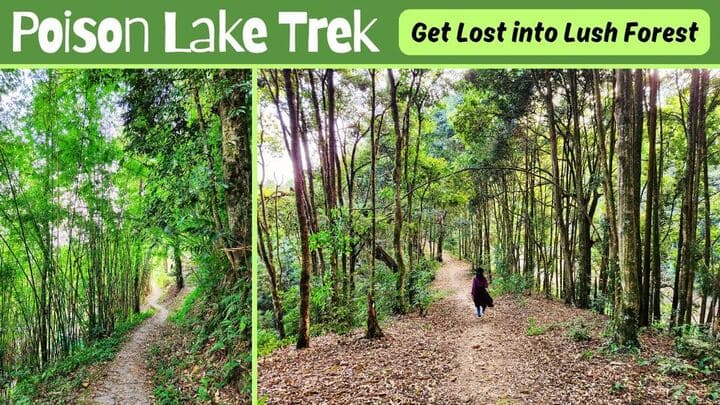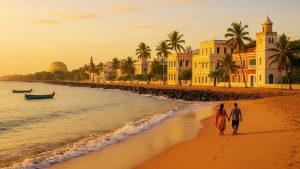Have you ever stumbled upon a place so rich in history and mystery that it leaves you in awe? That’s exactly what we felt when we visited Poison Lake (Bikh Pokhari), a small yet fascinating lake near Rinchenpong in West Sikkim. This place is not just a scenic spot—yet, it carries a deep historical past, tied to the local Lepcha community’s resistance against British invaders.
History and Legends of Poison Lake
The name Poison Lake comes from an intriguing piece of history dating back to the British colonial era.
Once Nieng Dah was the only source of water in Rinchenpong (Nieng Dah is the past name of Poison Lake). In the 19th century when British forces attempted to take over the Rinchenpong region, but the Lepcha queen of that era denied British rule in her area. According to local folklore, by her order, the Lepcha people—Sikkim’s indigenous community—poisoned the lake using toxic herbs.
Many British soldiers who drank from it fell ill or died, forcing the invaders to retreat. Even today, some locals believe the lake’s water remains unsafe to drink, adding to the eerie charm of this place.
Journey to Poison Lake: A Wrong Turn can lead you to Deep Forest (Caution)
While exploring Rinchenpong with our family, including kids, we were excited to explore this legendary spot.
According to the car driver, the hike to Poison Lake is a short stroll into the forest. But we made a mistake at a fork in the path. Instead of taking the right turn, we unknowingly took the left path, leading us deeper into the hill forest.
At first, the walk through the lush green surroundings was a wonderful experience. The sound of birds, the fresh air, and the feeling of being close to nature made it a delightful adventure. Nevertheless, after 40 minutes of hiking without finding the lake, we started feeling uneasy. Traveling with kids in an unfamiliar forest is not the best idea, and we decided to turn back.
Realizing our mistake, we retraced our steps, hiking uphill back to the original point where we had taken the wrong turn. Once back on track, we took the right direction—and within just 5 minutes, we reached Poison Lake.
So, a serious note for you, if you plan to visit Poison Lake during your Rinchenpong sightseeing, after entering the forest, must follow the right-directed route, NOT the left path.
When to visit Poison Lake — Winter or Monsoon?
When we finally reached the lake, we were surprised—it was completely dry! And just for note, it was winter when we visited Rinchenpong. Later, we learned that Poison Lake remains dry in winter but fills up during the monsoon season.
Though there was no water, the eerie silence, coupled with the historic aura of the place, gave us chills. Surrounded by thick forests, the lake basin seemed to hold countless untold stories within its depths.
Even though the lake remains dry in winter, it is the best time to visit there. Firstly, in winter the forest remains dry, while in monsoon the wet and slippery landscape may hurt you. Secondly, winter is the best time to visit Rinchenpong or Kaluk, or even West Sikkim, in terms of the clear view of Mount Kanchenjunga. Thirdly, landslides are very common on hilly roads during monsoon. That’s why it’s better to avoid mountain trips in monsoon seasons.
You can visit this part of Sikkim anytime between September to May. During post-monsoon season (September-October) the Poison Lake remains filled.
Why Visit Poison Lake?
- For the history: For its history: If you love exploring places with historical significance, this lake has an incredible story of freedom fight. It’s a place of resistance against British colonial invasion.
- For the adventure: The short trek through the forest adds a sense of excitement.
- For the experience: Whether dry or full, the lake holds a mysterious charm.
- For nature lovers: The surrounding greenery is breathtaking.
Travel Tips for Visiting Poison Lake
- Take the right route: Ensure you stay on the correct path to avoid unnecessary trekking.
- Best time to visit: Winter, if you want to experience the best view of Snow-capped Mt. Kanchenjunga. Post-Monsoon (September-October), if you want to see the lake filled with water.
- Footwear: Wear sturdy shoes, as the trail can be uneven and muddy.
- Go with a group: The area is secluded, so traveling in a group is advisable.
Other Places to Visit Nearby
- Rinchenpong Monastery
- Rinchen Cholin Monastery
- British Bungalow
- Kaluk
Final Thoughts
Despite our little adventure of taking the wrong turn, visiting Poison Lake was a memorable experience. Its historical significance, combined with the beauty of the surrounding forest, makes it a must-visit spot for anyone traveling to Rinchenpong. Whether you seek history, adventure, or simply a peaceful escape into nature, Poison Lake will not disappoint!
Have you ever taken a wrong turn on an adventure? Let us know in the comments!
Ms. Subhra Das is a biology teacher in high school. Besides she is a passionate traveler, science writer, and nature lover.
As a teacher, she never restricts herself to the four walls of the classroom, rather she loves exploring the crude science behind the natural facts that include human and animal health, critical diseases, typical characteristics of wildlife, and mother nature.
Ms. Subhra Das is also a passionate traveler and explorer; she always tries to uncover natural flora and fauna at every destination she travels.







